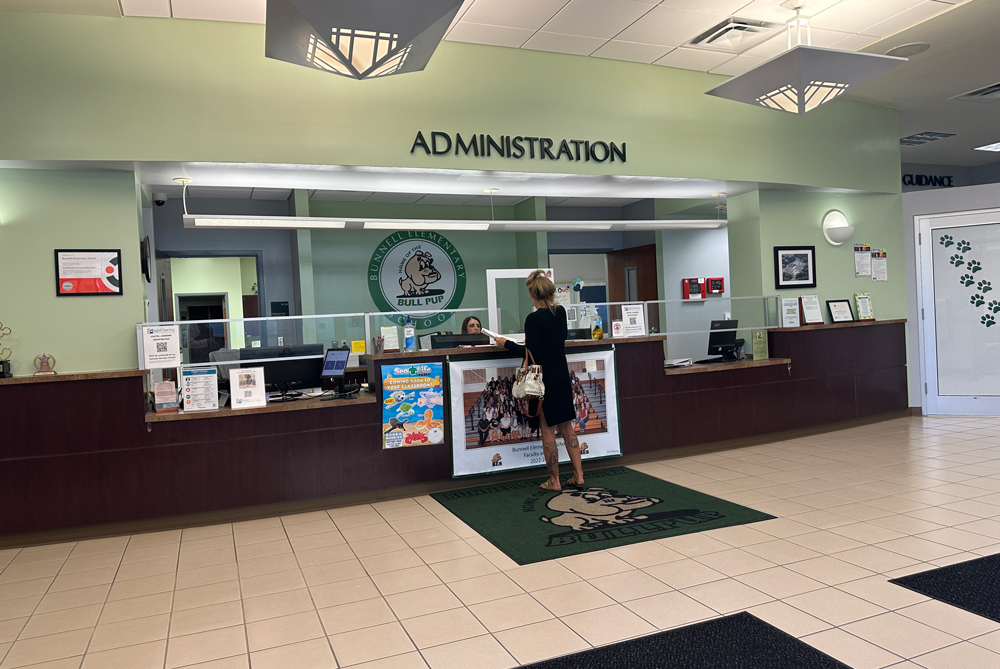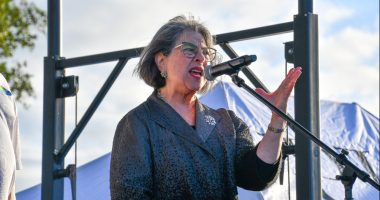
Bunnell Elementary school’s leadership environment that enabled a trio of teachers to hold assemblies targeting only Black students last month was disjointed, incurious, careless and oblivious to the optics of segregating Black students in the name of improving test scores, regardless of their academic standing, a pair surprisingly limited and identical internal investigations reveal.
The investigations confirm without doubt what has been previously reported, including the way a teacher told students they could end up jailed or killed if they did not perform better, the way they were shown a shoddily written presentation that called them a “problem,” the way they were paired against each other in a bracketed competition, the way better-performing students were show off as models, and the way they were promised food from Chick-fil-A and McDonald’s if they did well.
What was not known until now were the dynamics behind the assemblies among staff, and the degree to which Bunnell Elementary’s checks and balances failed, and not only because of Donelle Evensen, the former principal who approved the presentations and the assemblies: others who could have raised more questions and shown more curiosity about the plan did not do so, and ultimately not a single member of the 4th or 5th grade faculty did so, either, even though they all received Evensen’s email singling out Black students and asking them to send them down to the cafeteria.
Evensen has resigned. So has Anthony Hines, the teacher who conceived of and led the assemblies. He led the two assemblies–one for all 4th grade Black students, one for all 5th grade Black students–on Aug. 18 with teacher Tonya Steed and Gary Gabriel, who is in charge of in-school suspensions. Steed, Gabriel and Hines are all Black.
Only Evensen and Hines were investigated in separate but mirror investigations, which the district issued in summary form just past noon today, though the documents were releasable Sunday. (See the Evensen investigation here, the Hines investigation here.)
The documents were released only after they could be paired with a terse statement from the superintendent (“My message is the same as I’ve told the parents of Bunnell Elementary Schools: this was unacceptable. We will do better, and that begins with transparency and training for all our staff, administrators, and educators,” Superintendent LaShakia Moore was quoted as saying. Moore’s appointment of Evensen was her first of a principal in her superintendent tenure, only weeks before the assemblies.)
The documents did not include the full materials that typically make up investigations, such as complaints or accounts of complaints from parents or others. The investigations state that “it is alleged” that the assemblies took place, but does not document the source of the allegations. Nor do the investigations include any interviews with parents or students, though it isn’t at all uncommon for internal investigations to do both, especially when students were the direct victims of “unacceptable” behavior. Nor do the papers released by the district include documentation from the committee that reviewed the investigations before recommending actions to Moore.
The committee was made up of Michael Rinaldi, coordinator of professional standards, Kristy Gavin, the school board attorney, Robert Ouellette, chief of human resources, Angela O’Brien, director of organizational talent, Marquez Jackson, director of student services, and Dave Freeman, chief of operational services.
Though focused on Evensen and Hines, the investigations reveal that those involved, to lesser extents, were Marcus Sanfilippo, the former principal at Bunnell who was transitioning to his new role as coordinator of special projects and who originally green-lighted Hines’s plan in embryo, and Cari McGee, the assistant principal. McGee told the investigator she “missed” the email Evensen had sent her outlining the plan for the segregated assemblies. She said she was never part of the discussions about it nor aware of Hines’s broader mentorship plan for Blacks students. When she heard two teachers at the end of the day talk about how “weird” the assemblies were, she did not stop to inquire further.
Rinaldi, the professional standards coordinator who conducted the investigations, interviewed Sanfilippo three times–on Aug. 22, Aug. 24, Aug. 29–with increasingly insistent questions about whether Sanfilippo knew of the plan to segregate the students in an assembly. Sanfilippo just as insistently said no, that his involvement was limited to the early stages of Hines’s idea to expand a mentorship program he’d led the previous year with a limited number of students. Hines wanted to expand it to all Black students and had discussions about it last May with Sanfilippo and Evensen.
There was no talk of assemblies at that point–assemblies were extremely rare in Sanfilippo’s seven years as principals, and were limited to such things as “Terrific Kids” recognitions–but and asked Sanfilippo to provide him with testing data of all Black 4th and 5th graders. Sanfilippo did so, without asking about Hines’s broader plans, or how he would roll it out, though Hines also told Sanfilippo of the competition brackets he planned.
“Mr. Sanfilippo said there was no discussion about an assembly, or meeting, or full group, or an introductory meeting,” the investigation states. That was in May (a meeting Hines described as a “popup” meeting, not something formal). Hines again met with Sanfilippo and Evensen on Aug. 2, barely two weeks before the assemblies. “Mr. Sanfilippo explained that it was not a formal meeting that was scheduled,” the investigation states. “Mr. Hines asked Mr. Sanfilippo for the number of African American students in both the 4th and 5th grade because he wanted to be able to reach them all, but according to Mr. Sanfilippo, not in a whole group setting.”
Sanfilippo appears not to have asked how Hines intended to reach all the students. But Sanfilippo was up to speed on the food incentives, and told Evensen about that when she walked in. Rinaldi again asked Sanfilippo if there was any discussion of an assembly. Sanfilippo said, “there was not any discussion that I can recall for a whole group presentation.”
Read Related Also: SNP's soft touch drugs policy will end in more deaths – a devastating warning from the US city that decided to decriminalise drugs
Evensen received Hines’s powerpoint presentation on Aug. 9, just seven days after that meeting–a powerpoint presentation that was addressed to all African-American 4th and 5th graders, strongly suggesting that some discussion of a presentation to all such students had taken place. Evensen approved it (“looks good,” she told him in a hallway), apparently not picking up on the presentation’s carelessness or insensitivity.
It was Sanfilippo who suggested to Hines to work with Steed and Gabriel, the two Black teachers who were present at the assemblies. Sanfilippo thought Steed had a good way to relate with Black female students. It isn’t clear why Gabriel, a disciplinarian, was included, why no non-Black faculty were proposed, or how Gabriel was to be involved. (The district’s African-American mentorship program does not exclude non-Blacks from being mentors.)
Hines himself was asked if he’d mentioned the assemblies to Sanfilippo and Evensen at that Aug. 2 meeting. He told the investigator that–in the investigator’s paraphrase–“at that point he really didn’t know and that he was just trying to get as many students involved in the program as he could. He added that he wasn’t sure what the size of the group he would be meeting with from the 4th and 5th grade African American students would be and he wanted as many as possible and anticipated that it could be all.”
But he wasn’t aware, he told the investigator, until Evensen’s Aug. 16 email to faculty that he would have all Black students.
At no point was the possibility of having non-Black, low performing students included. At no point, in any of the discussions, including those with Sanfilippo and Evensen, was the notion of segregating the students questioned or the optics discussed–at least not according to anything the investigator reported.
Sanfilippo said the Aug. 2 meeting was the last of his involvement in the plan until he started getting texts about it on Aug. 18, when parents were scandalized about it on Facebook.
Rinaldi interviewed Hines twice. The investigation reveals Hines to be more naive and lacking guidance or good judgment than malicious, especially since his intention was to expand what to him had been a very successful program: 65 percent of his students in his mentoring program the previous year had met their improvement goals. He said he wanted to include all Black students in the same method, and include high performers as “good examples for all students.” But he also conceded that “it wasn’t given a lot of thought” because he took the high performers and put them on stage “as academic leaders and heralded them so everyone was included.”
In other words, he somehow saw two assemblies designed on segregated parameters as inclusive.
Hines did not sugarcoat what he told the students about early graves: “Yes I did,” he told Rinaldi, when Rinaldi asked him if he’d told the students they could face jail or death. Hines said: “What was said was, in my experience the friends and people that I grew up with that made bad choices and didn’t do well in school ended up in jail, shot or are not with us anymore.” He said he was speaking from the heart, and that the words were not approved by Evensen. If Rinaldi asked him what he thought about the propriety of that kind of language with 4th and 5th graders, the investigation does not reflect it.
Rinaldi did ask Hines if at any time during the planning of the assemblies Evensen or anyone else questioned why all Black 4th and 5th graders would make up the assemblies. “No one in administration said don’t invite them all,” he was said to have replied.
The only teacher who raised questions to Evensen–Melissa Anderson, a 4th grade teacher–did so not on segregation grounds exactly, but because Evensen had not attached a list of actual students to be called out, and some teachers were uncomfortable doing so without a list.
“This incident was not indicative of Flagler Schools, and we have much to do to regain the trust of many in our community,” Moore said in her statement today, signaling what she is calling a “Community Connection forum” on Sept. 27 at 6 p.m. at the Carver Center to further discuss the issue. The forum had originally been scheduled the week when Hurricane Idalia briefly shut down schools and led to many postponements.
![]()







